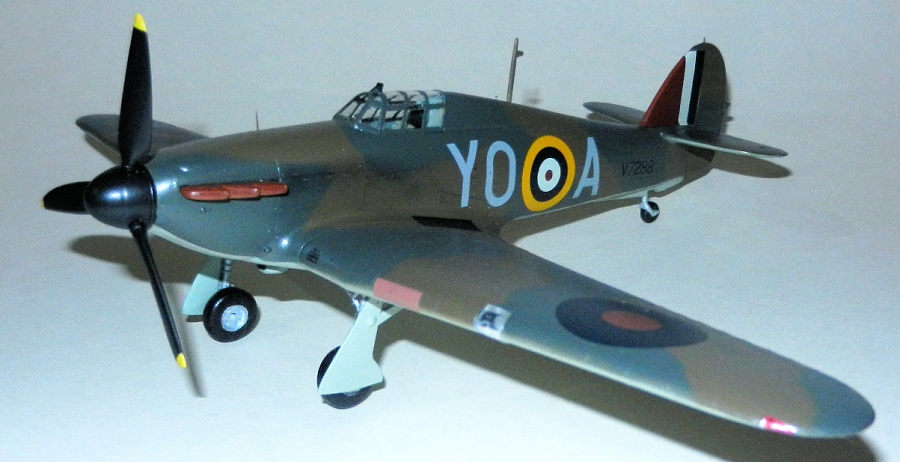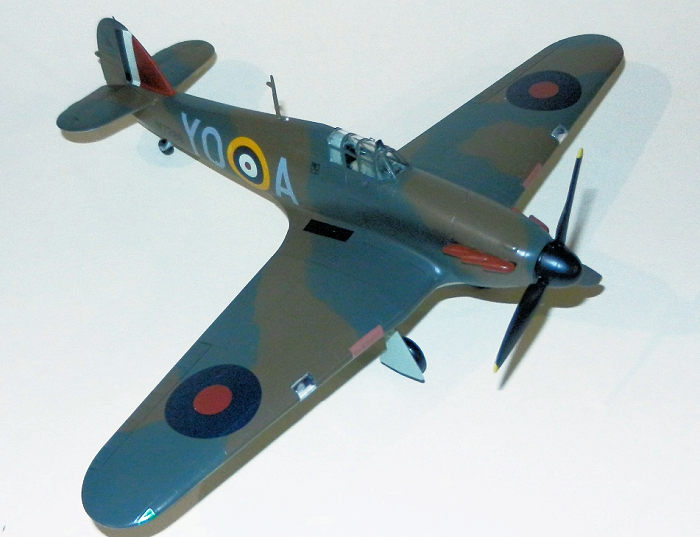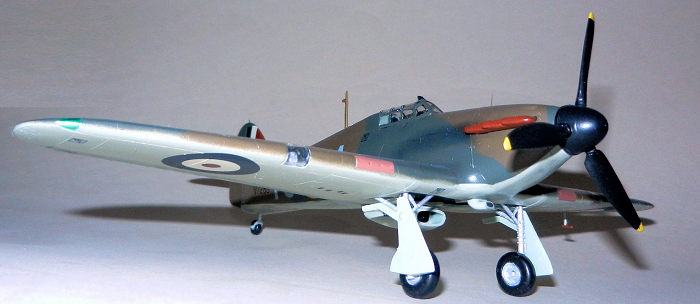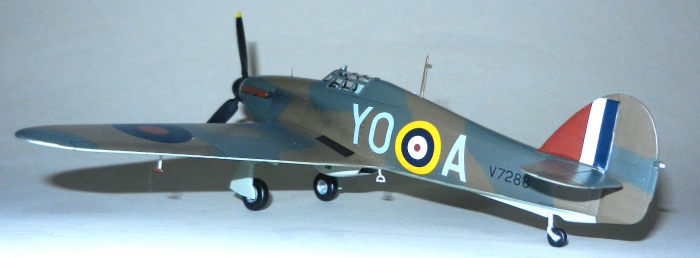
| KIT #: | 04102 |
| PRICE: | |
| DECALS: | Two options |
| REVIEWER: | Pablo Calcaterra |
| NOTES: | Original tooling |

| HISTORY |
Ernest (“Ernie”/”Pee Wee”/”The McNab”) Archibald McNab was born on 7th March 1906 in Rosthern, Saskatchewan, Canada. He attended the University of Saskatchewan where he learnt to fly. He played hockey and football with the Huskies. He decided to join the RCAF on June 3, 1926. Two years later he received his wings and then was trained to fly seaplanes on the West Coast. In 1929 he was granted leave to finish his university studies. He graduated as a Bachelor of Science in Engineering and returned to active duty in 1930. He was a member of the Siskin aerobatic team in 1930 and 1931. Between 1937 and 1939 McNab was sent to the UK to further his knowledge and joined 46 Squadron at Kenley as a Flight Commander. During exercises in 1937 and flying in biplane fighters McNab and his colleagues managed to intercept some Blenheims…only to see them leave them behind. At that time this incident further instilled the thought that “the bomber will always get thru”. He flew Hawker Harts, Gloster Gladiators and Hawker Hurricanes. During this time he met the Canadian Johnny Kent who was serving in the RAF.
He was very experienced and had flown more than 2,000 hours including photographic surveyance of the Hudson Bay.
Promoted to Squadron Leader in April 1939 he returned to Canada after the war broke and he test flew P-40 and a Spitfire. McNab was put in charge of the 1st Canadian Hurricane Squadron in November of that yearThese planes were fabric wing ones, with 2 blade propellers.
 The idea had
been that 1 (RCAF) Sqn was to support the 1st Canadian Army in France but the
latter collapsed before the plan was put in place. Taking command of his
Squadron based in St. Hubert (QC) in November 1939 McNab led them to the UK
where they arrived by sea on 20th June 1940. Five days later they were visited
by Air Chief Marshal H. Dowding who noticed that these Hurricanes were totally
inadequate for the air combat environment. Five days later June 30 these old
planes were swiftly allocated to OTUs while 1 (RCAF) Sqn received new
Hurricanes.
The idea had
been that 1 (RCAF) Sqn was to support the 1st Canadian Army in France but the
latter collapsed before the plan was put in place. Taking command of his
Squadron based in St. Hubert (QC) in November 1939 McNab led them to the UK
where they arrived by sea on 20th June 1940. Five days later they were visited
by Air Chief Marshal H. Dowding who noticed that these Hurricanes were totally
inadequate for the air combat environment. Five days later June 30 these old
planes were swiftly allocated to OTUs while 1 (RCAF) Sqn received new
Hurricanes.
To be better prepared to lead his men in combat he joined 111 Sqn, also based at Croydon. During his first combat on August 15th he shot down a Do17 of 6/KG3 after a couple of attacks. When the squadron was made operational they moved to Northolt along with 1 Sqn RAF and 303 (Polish) Squadrons. They had a disastrous start when on the 24th they shot down 2 Blenheims of Costal Command by mistake killing 3 aircrew.
On the 26th during the first engagement with the Germans by 1 (RCAF) Sqn Sqn McNab claimed a Do17 destroyed (subsequently his Hurricane was seriously damaged, crash landed and was written off), and this made him the first pilot in a RCAF squadron to destroy an enemy. His score built in the following days. His final score was 4 1/3 confirmed, 1 probable and 3 damaged. And all this being 34 years old.
From the war diaries we find this entry:
“September 20: F/L Alex Kentski, ex-Canadian and now flying with the Polka Escadra (Polish Squadron), entertained before dinner with an impromptu sleight-of-hand show and a certain amount of aerobatics which baffled the onlookers completely.”
In October McNab was awarded the DFC (the first to be received by a member of the RCAF) and promoted to Wing Commander.
By the end of September the squadron was low on planes and pilots (between colds and war related injuries/kills)
 When 1
(RCAF) was moved north for a rest on October 10th they had a score of 30 claimed
kills, 8 probably and 32 damaged. In the process they suffered 3 killed and 10
wounded (I always scratch my head at this way of presenting the information…this
means around 13 planes shot down…I feel it is a sneaky way to present the
situation on a brighter light…not lying…but not entirely fair) Counting the
losses as described in High Blue Battle we have 18 Hurricanes lost and 1
severely damaged that landed in another airfield). If overclaiming during the
battle by the RAF was 2:1 this means the actual number of kills of 1 (RCAF)
Squadron was around 15…having lost 18 planes. Best case scenario they ended the
battle break even. Besides McNab there were two more DFCs handed to pilots in
the squadron.
When 1
(RCAF) was moved north for a rest on October 10th they had a score of 30 claimed
kills, 8 probably and 32 damaged. In the process they suffered 3 killed and 10
wounded (I always scratch my head at this way of presenting the information…this
means around 13 planes shot down…I feel it is a sneaky way to present the
situation on a brighter light…not lying…but not entirely fair) Counting the
losses as described in High Blue Battle we have 18 Hurricanes lost and 1
severely damaged that landed in another airfield). If overclaiming during the
battle by the RAF was 2:1 this means the actual number of kills of 1 (RCAF)
Squadron was around 15…having lost 18 planes. Best case scenario they ended the
battle break even. Besides McNab there were two more DFCs handed to pilots in
the squadron.
On November 2nd he was succeeded by the newly promoted S/Ldr McGregor and the squadron delivered a farewell party to McNab on November 11th. He was repatriated to Canada in 1941 where he led 118 Sqn defending the Canadian East coast. Then he returned to serve at RAF Digby from late 1942 till the end of the war.
McNab was made an OBE in 1946 and received the Czech Military Cross. He retired from the RCAF in 1957 as Group Captain, not being promoted in many years because of his apparent lack of administrative skills and internal jealousy. He lived in Vancouver till he passed away on January 10, 1977.
Regarding his Hurricane during the BoB: . Though Shores claimes his plane was YO-W photographic evidence seems to show that it was YO-A and I went with this one. Moreover Shores uses the same serial number for all of McNab’s kills when we know that he was shot down during his first battle with his squadron. Then I found on line that V7288 (the plane I have built) seems to have ended up in Greece with 80 Sqn and was lost with his pilot (“Ape” McCullen) in Albania/Greece during his first combat in a Hurricane. McNab for instance flew on P3069 on October 4th when his plane was damaged in combat (also YO-A).
| THE KIT |
This version of the old classic Airfix kit released in 1979. My boxing is the 1983 version. It has been totally superseded by Hasegawa and the same Airfix. It’s extremely simple but in general has very good external lines. It certainly looks like a Hurricane (though it has a floor for the cockpit and this we know is not correct…once you glue the canopy you barely can see the seat…so don’t even think about seeing the “floor”). What we would say a kit for starters.
| CONSTRUCTION |
 There’s not
much in the cockpit as the frame is molded on the walls. Instrument panel with
decal, stick and tape painted to represent the seat belts was all it took to put
it together.
There’s not
much in the cockpit as the frame is molded on the walls. Instrument panel with
decal, stick and tape painted to represent the seat belts was all it took to put
it together.
Fuselage halves required a nice amount of putty as it is to be expected with the back part of the spinner in place. Bottom half of the wings was put in place and while the glue was drying the two top halves were added to try to move things around to minimize the gap with the fuselage. Regretfully there was more putty to be used, and more rescribing.
Horizontal tail surfaces with putty came next followed by the landing gear, the radiator bath and the small intake under the chin. In a few short sessions I was ready to start painting the Hurricane.
| COLORS & MARKINGS |
Canopy and windshield were given a coat of Vallejo black primer. Then everything received a coat of Vallejo light grey primer. White was used for the tail band which was then masked and sprayed red all the way to the front of it. Finally red and white were masked and blue was applied.
Undersides were painted RAF Sky using Model Master Acrylics. Then with this masked the top as well was painted with RAF Dark Brown and then RAF dark Green (from MM Acrylics). Propeller and wheels followed in black. With a black pencil I carefully drew the opening of the small scoop under the nose.
 Sanded
black pastel applied with a Q tip dirtied the kit especially around the
moveable surface areas and undersides. A thin black pencil highlighted
rudder, elevators, flaps and ailerons. Future got the surfaces ready for the
decals.
Sanded
black pastel applied with a Q tip dirtied the kit especially around the
moveable surface areas and undersides. A thin black pencil highlighted
rudder, elevators, flaps and ailerons. Future got the surfaces ready for the
decals.
For this kit I used a combination of the kit’s (stencils, national insignias), Carpena for the serial number and Xtradecals for the grey squadron letters. They all reacted very well to Set and Sol. As this kit does not have the holes for the used cartridges I took Richard Caruana’s drawings and made a decal on clear film. These 2 “panels” were placed under the wings.
Navigation lights were painted using silver and then clear red and green. The one on the tail was just painted white. Wheels and landing gear doors were attached, followed by the pitot. Windshield/canopy single piece was glued in place after installing the gunsight.
I attached the exhausts (rust with some drybrushing with bronze). I finally added the antenna mast, the propeller blades and spinner and with this the kit was finished.
| CONCLUSIONS |
A very simple but effective kit that can help us to clean our mind when we are bogged down with a more modern (but complex) kit.
| REFERENCES |
Ernie McNab (flyingforyourlife.com)
RCAF’s first Distinguished Flying Cross - Legion Magazine
High Blue Battle (D. McIntosh)
Legion Magazine
Battle of Britain 1940 (D. Dildy)
Aces High (Shores)
University of Saskatchewan website
Canadian Aerospace Leadership Studies Volume 1
https://www.silverhawkauthor.com/post/canadian-warplanes-3-hawker-hurricane. This is the website that contradicts all others and says that both his Hurricanes were YO-A
2 October 2023 Copyright
ModelingMadness.com. All rights reserved. No reproduction in part or in whole
without express permission. If you would like your product reviewed fairly and fairly quickly, please
contact
the editor or see other details in the
Note to
Contributors.